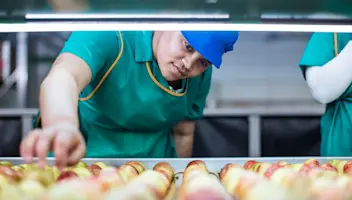Featured in this post
Food Traceability Regulations: Understanding Universal Standards, Regional Differences and What It Takes to Ensure Food Safety and Compliance
Food Traceability Regulations: Understanding Universal Standards, Regional Differences and What It Takes to Ensure Food Safety and Compliance
29 Mar 2022
Jack Payne
Between the greater emphasis on public health brought on by the COVID-19 pandemic and consumers’ increasing demands for transparency and safety on the part of brands they support, food traceability regulations and legislation are hot topics of late.
Amidst all the discussion, it can be difficult to determine how the various administering agencies differ and what standards are applicable to your company. Some requirements pertain only to specific regions or verticals, so certain expectations will be more relevant to your operations depending on where your facilities are located and which segment your products fall under.
That being said, your business will need to be prepared to meet increasingly stringent traceability standards going forward, regardless of the nature of your organization. Having a broader understanding of the full scope of the many existing programs and the purposes behind them can help you to fulfill your obligations and account for any impending changes.
In this post, we’ll provide some greater context behind food traceability legislation, the universally accepted sets of standards that exist, and the different regional requirements as laid out by law. Read on for the full deep dive and a firm grasp of what these developments mean for the industry at large and your organization in particular.
Historical Context and Universally Accepted Standards
The first major international agreement on food safety standards was established by members of the World Trade Organization (WTO) in the Codex Alimentarius. This established the “Recommended International Code of Practice – General Principles of Food Hygiene,” which was based on the provisions laid out by Hazard Analysis Critical Control Point (HACCP).
Other organizations and their standards have also been embraced on a global level. Each of the following have created more detailed requirements specifically related to ingredient and product traceability:
The Global Food Safety Initiative (GFSI), launched in 2000, is widely regarded as one of the top international authorities on food traceability. Specifically, its incorporation of GS1 labeling standards has helped to push traceability efforts forward.
The Safe Quality Food Institute (SQFI), which is a division of the Food Industry Association (FMI), built upon previous traceability standards and grants the well-recognized SQF certification for those food and beverage businesses that demonstrate a commitment to a culture of food safety.
Foundation FSSC created the Food Safety System Certification 22000 (FSSC 22000)—which defines the risks and hazards in food and beverage manufacturing that can be effectively managed with sound traceability procedures—as well as Pre-Requisite Programs (PRPs) by product segment.
BRC Global Standards (BRCGS) cover traceability with specific regards to handling, storage, distribution and packaging. A related certification that is recognized in more than 130 countries can be obtained from any of a number of auditing organizations.
Current Good Manufacturing Processes (cGMP) originally began under the auspices of the U.S. Food and Drug Administration (FDA) but have since been adopted internationally for minimizing risks in production, processing and packaging of food and beverage products.
While it’s unlikely that any of these agencies are new to you as a food and beverage business professional, it’s vital to understand that collectively, the guidance they provide forms the basis of modern best practices for traceability, as well as the following regional regulations.
Food Traceability Regulations in the U.S.
Interestingly, the very first stipulations for food and beverage traceability in the United States were laid out in the Bioterrorism Act of 2002, which established the oft-cited “one step forward, one step backward” paradigm for tracking of materials and goods. Needless to say, the greater scrutiny placed on food safety in the intervening years has led to some significant changes.
Those began with the passage of the Food Safety Modernization Act of 2011 (FSMA), of which Section 204 addresses traceability specifically. This put the responsibility for establishing a system for rapid tracking and tracing of food and beverage products on the businesses manufacturing them with a goal of mitigating the risks of a foodborne illness outbreak.
Then, in July 2020, the FDA published the blueprint for the New Era for Smarter Food Safety, which among other measures emphasizes the critical role that technology will play in advancing traceability efforts in the industry. The plan aims to encourage and incentivize adoption and promote digital transformation initiatives for higher visibility of information and greater agility in emergencies.
Now, the U.S. food and beverage market awaits the official passage of the Proposed Rule for Food Traceability. This 55-page document lays out the Food Traceability List (FTL)—a set of 16 foods that pose an elevated level of risk—as well as the Key Data Elements (KDEs) that must be captured at various Critical Tracking Events (CTEs) along the supply chain. Check out our full post on the Proposed Rule.
Food Traceability Regulations in the EU
In the member states of the European Union, the General Food Law Regulation set forth by the European Food Safety Authority establishes the traceability requirements for food and beverage operators. The most important provisions are included in Regulation (EC) No. 178/2002, which states that a comprehensive system of traceability within food and beverage businesses is necessary to protect consumers from the risks of contaminations in the supply chain.
As stated in the legislation, the goal is to facilitate the withdrawal of faulty products from the market and provide consumers with accurate information. At the time of its original passage, the law did not specify the form or structure of the traceability systems it references, but more information and practical guidance has since been developed.
Several supplementary documents—including the Factsheet on Traceability published in 2007 and leaflet on Key Obligations of Food and Feed Business Operators—cover in more detail what is expected of food and beverage businesses on this front. What’s more, a separate document on implementation of the law helps businesses put the necessary measures into practice.
Of note on this subject, the findings of a Global Food Traceability Center (GFTC) report indicate that EU countries rank higher than others around the world as far as the strength of their food traceability regulations and requirements, as well as member states’ adherence to them. This demonstrates that, when effectively implemented, a codified set of mandatory requirements can improve outcomes even across a broad, diverse group of businesses.
Food Traceability Regulations in the UK
In the wake of Brexit, food and beverage regulations in the United Kingdom have changed and evolved while retaining some relevant provisions laid out in EU legislation. While Northern Ireland remains subject to EU law alone, Great Britain, Wales and Scotland fall under the provision of the Food Standards Agency (FSA) as the government organization responsible for setting and enforcing traceability requirements.
A quick reference guide published by FSA specifies that food business operators (FBOs) must maintain traceability information for suppliers and customers—equivalent to the “one step forward, one step backward” model mentioned above. It also contains guidance on the necessary labels and identifiers that should be placed on products to facilitate this practice, as well as additional requirements for goods of animal origin and sprouted seeds.
Additionally, that same guide covers key steps in developing a food traceability system, the process for withdrawals and recalls, as well as where the responsibility for critical functions—like informing consumers of safety issues and disposing of contaminated goods—lies. By and large, the legislation places the onus on the FBOs to maintain complete records, devise their traceability approach and conduct the necessary steps in a recall.
Food Traceability Regulations in Other Countries and Regions
Outside of the U.S., EU and UK, other countries have their own agencies for food safety and varying levels of regulation on traceability.
For example, the Canadian Food Inspection Agency is responsible for safeguarding consumers from the risks of food safety emergencies, and its new Safe Food for Canadians Regulations are again modeled on the “one step forward, one step backward” paradigm. Meanwhile, the Agency’s Food Safety Enhancement Program (FSEP) contains requirements specific for processed meat traceability.
In Australia and New Zealand, Food Standards Australia and New Zealand is comparable to the U.S.’s FDA in terms of its level of industry oversight, but thus far the organization has only laid out traceability regulations pertaining to livestock identification and movement. Japan has passed legislation for the traceability of beef products and rice, but provisions for other sectors are still in development.
China, which ranked poorly in the GFTC report referenced previously, is also still in the process of developing a set of traceability standards, though legislation regarding livestock and other niche sectors does exist.
How Digital Transformation and Purpose-Built Solutions Improve Traceability Outcomes
We’ve discussed in some detail the many different agencies and bodies of law regarding traceability around the world, and while that knowledge can be important for creating your strategy, you still may feel like you lack the tools to effectively manage an organization-wide traceability plan. This is why digital transformation in the food industry, and the implementation of industry-specific solutions, is so important.
With an enterprise resource planning (ERP) system that can integrate with handheld barcode scanners and update your database with critical product information in real time, you can be assured that your data is complete. You can also import information from your supply chain partners to make sure you have the necessary means to track contaminations to their source.
An advanced food ERP platform, like Aptean Food & Beverage ERP, puts all of this power at your employees’ fingertips with an intuitive, user-friendly interface built on the framework of Microsoft Dynamics 365. Better still, our offering can be deployed from the cloud for maximum flexibility and minimum up-front costs—not to mention better stability and security thanks to our dedicated IT teams and redundant offsite servers.
Producing the necessary documentation for food safety authorities and even automating some portions of the recall process are also simple, streamlined exercises in the case of our offering. Our teams also have decades of collective experience and can guide your business in the implementation of the system as well as the incorporation of industry best practices in your processes.
So, ready to hear more about Aptean Food & Beverage ERP and how it can drive better traceability outcomes for your company? Contact us today, or schedule a personalized demo to see our product in action.
Related Content





Start increasing traceability in your operation
If you’re ready to take your food or beverage business to the next level, we’d love to help.



